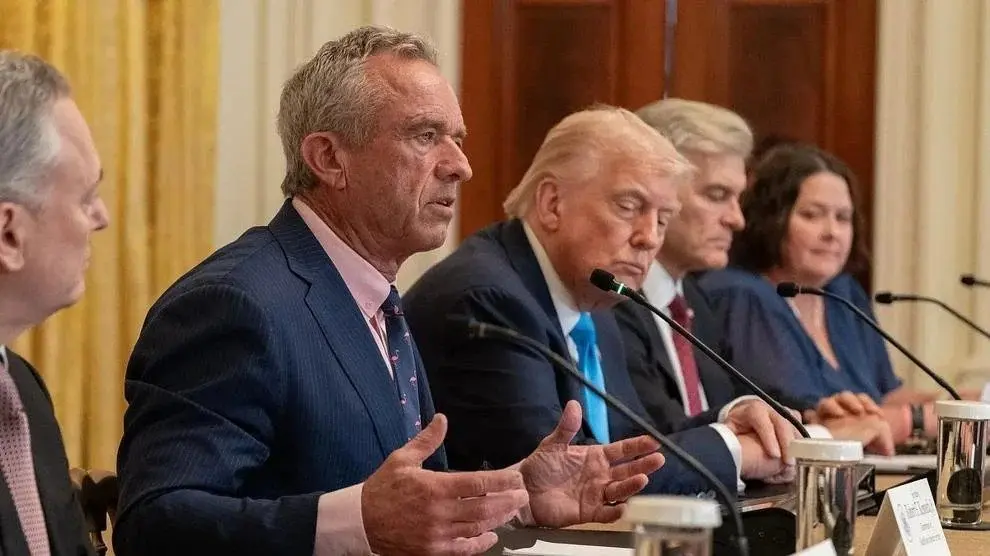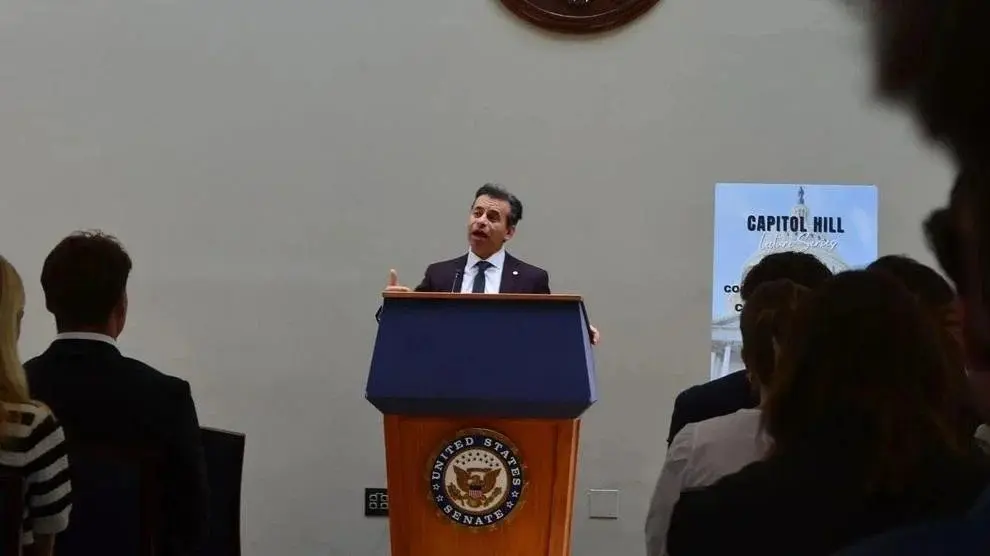WASHINGTON, D.C. – Hundreds of thousands of more children in the United States are going without health insurance, and experts warn that actions by the Trump administration and Congress will likely make the problem worse.
The national uninsured rate for children and teens rose to 6% in 2024, up from 5.4% in 2023, according to new year-over-year data released by the U.S. Census Bureau in September. The rate is the highest in a decade and follows a trend of childhood coverage losses that began a few years before COVID-19 arrived and picked up again after the pandemic emergency response.
“The storm clouds are gathering for people who rely on public health insurance and Medicaid, but for children, sadly, they are already here,” said Joan Alker, executive director of the Center for Children and Families at Georgetown University, during a briefing on the new child health data.
Last month, the center released an analysis of the latest census data, finding an 18% increase in the number of uninsured U.S. children between 2022 and 2024. The upsurge — which represents more than half a million additional kids who lost health coverage — affected nearly every racial and ethnic group. American Indian and Alaska Native children still had the highest uninsured rate by far, at 12.4% in 2024, compared to 9.7%, 5.5% and 4.9% among Hispanic, Black and white children, respectively.
Twenty-two states experienced a “significant increase” in the rate of uninsured kids from 2022 to 2024, according to the analysis. Just one state, New Hampshire, reported a “significant decrease,” from 3.4% to 2.3%.
Texas continues to have the highest rate of uninsured children ages 18 and under, at 13.6% in 2024, up nearly 3 percentage points from 2022. About 1.1 million Texas kids went without coverage last year, making up nearly a quarter of the nation’s 4.6 million uninsured children.
States with Medicaid expansion for low-income adults — now effective in all but 10 states — had lower uninsured rates among children than states without expansion on a cumulative basis, the Georgetown analysis found. Some expansion states still have relatively high rates, and non-expansion states relatively low ones.
Bruce Lesley, president of First Focus on Children, a national, bipartisan advocacy group, said he fears even more children will lose health coverage as states wrangle with the approximately $1 trillion in federal Medicaid cuts included in H.R. 1, the “big, beautiful” tax-and-spending bill that President Donald Trump signed in July.
“For 20 years, we cut the uninsured rate for kids — it’s probably one of the most significant things to happen to American children in a half a century,” Lesley said. “Now we’re going backward.”
Here are some answers to key questions on the issues based on data and interviews with advocates and experts.
Why is the children’s uninsured rate rising again?
In 1997, the year President Bill Clinton signed the budget bill creating the Children’s Health Insurance Program (CHIP), 15% of U.S. kids — or 10.7 million — were uninsured, up from nearly 14% a couple of years earlier.
CHIP covers kids who don’t qualify for Medicaid but whose families can’t afford private coverage. Its creation led to a dramatic upswing in kids covered by both CHIP and Medicaid because of more intensive outreach efforts, according to federal officials. By 2016, coupled with the effects of the 2010 Affordable Care Act, the rate of uninsured children dropped to a historic low of 4.7%.
Soon after, it started inching back up. By 2019, it was at 5.7%.
Lesley attributed the reversal to a number of actions by the first Trump administration, including weakening “welcome mat” programs and singling out coverage of lawfully present immigrants for additional scrutiny. For example, it slashed funding for ACA marketplace navigators, who help families find affordable coverage, by 84%.
It also expanded the “public charge” rule — which immigration officials use to determine if a person will likely rely on public assistance — to include Medicaid. The change didn’t apply to kids, but researchers documented a chilling effect that led to a drop in Medicaid enrollment of hundreds of thousands of children. The Biden administration reversed the rule change.
More recent drops in kids’ health coverage — those reflected in the new census data — follow the expiration of emergency COVID-19 rules that had paused all Medicaid disenrollments. Millions of children nationwide lost coverage during the Medicaid “unwinding,” when states resumed eligibility checks in spring 2023.
Not every state tackled unwinding the same, and disenrollment rates vary widely. In Oregon, for example, children’s Medicaid enrollment declined about 2%. In Texas, it declined by more than 30%, or by 1.3 million kids, and mostly for paperwork reasons, not because they were ineligible.
“If all states had done as poorly as Texas did with the unwinding,” Alker said, “we would have seen a much higher jump in the uninsured rate of children nationally.”
Will the child uninsured rate keep going up?
According to Alker, “it’s probably happening as we speak.”
Many of the same factors that drove down child coverage in 2016-2019 are back in the second Trump term, she said at the briefing, including funding cuts to ACA enrollment assistance and heightened fears among immigrant families.
Earlier this year, federal health officials agreed to share personal Medicaid data with Immigration and Customs Enforcement. A judge ordered the administration to stop the practice.
One in 4 children and teens in the U.S. has at least one immigrant parent, KFF found.
“We’ve already had reports of families dropping coverage over data-privacy fears,” said Lynn Cowles, director of health and food justice at Every Texan, a nonprofit policy institute. “[Immigrants] are scared to go to appointments. … Health centers are getting more requests for telehealth.”
Children’s coverage will also take a hit if Congress lets enhanced ACA tax credits expire later this year. Enrollment in the ACA marketplace has more than doubled to over 24 million since enhanced credits became available in 2021. Those credits are at the heart of the impasse in Congress that’s led to the federal shutdown.
If the credits expire, out-of-pocket premiums will skyrocket and 4.2 million more people will be uninsured by 2034, according to estimates from the Congressional Budget Office. More than 2.1 million U.S. children depended on marketplace coverage in 2024, Georgetown researchers reported.
Cowles said more than 540,000 kids in Texas rely on ACA health plans. She expects many families will be priced out of the marketplace and become uninsured if tax credits expire.
State efforts that make it easier for low-income kids to stay insured face their own expiration date in Trump’s second term. In July, the U.S. Centers for Medicare & Medicaid Services said it would not renew or approve additional Medicaid waivers on multiyear coverage for children, citing spending concerns.
Nine states currently have such waivers to provide multiyear Medicaid coverage for kids from birth until age 6. Research shows continuous coverage in Medicaid or CHIP can reduce disenrollments and “churn,” or when kids move on and off the rolls.
In 2022, Oregon became the first state with a multiyear waiver. Dr. Ben Hoffman, a pediatrician at Doernbecher Children’s Hospital in Portland, said the uninterrupted coverage addresses a “critical developmental period” in a young child’s life, when access to preventive and screening services is key.
“We want to make sure kids are as healthy and as ready as possible for kindergarten,” he said.
Oregon’s waiver expires in 2027, meaning families would return to more-frequent eligibility checks. Hoffman hopes the state will make that process as seamless as possible, but he suspects the end result “will be terrible for kids.”
“It’s just an underhanded way to increase turnover and lower costs through attrition,” Hoffman said about CMS’ decision. “In what universe is it beneficial to anybody for a child not to have health insurance?”
Will kids feel the trillion-dollar cut?
Trump signed the sweeping tax-and-spending bill, H.R. 1, in July, approving the biggest federal funding cut in Medicaid’s history — almost $1 trillion over 10 years.
A loss that large likely won’t spare children.
“With almost half of the nation’s children covered by Medicaid and CHIP, they cannot be shielded from a cut of approximately 11%,” Alker said.
Lesley, at First Focus on Children, agreed. State responses to the funding loss will vary and it’s still early, but he worries that lawmakers will seek out cost savings by putting up more enrollment hurdles for families.
“These barriers can be really tragic,” Lesley said
This story is part of “Uninsured in America,” a project led by Public Health Watch that focuses on life in America’s health-coverage gaps and the impact of potential Medicaid cuts and lack of expansion.
This story was originally produced by Stateline, which is part of States Newsroom, a nonprofit news network which includes Idaho Capital Sun, and is supported by grants and a coalition of donors as a 501c(3) public charity.
Idaho Capital Sun is part of States Newsroom, a nonprofit news network supported by grants and a coalition of donors as a 501c(3) public charity. Idaho Capital Sun maintains editorial independence. Contact Editor Christina Lords for questions: info@idahocapitalsun.com.





